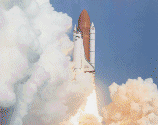Commit
to Launch: NASA Weather Instrumentation
The
equipment used by the forecaster to develop the downrange and launch
clearance forecast are:
 Radar:
The color weather radar display is located at the Cape Canaveral
Forecast Facility. The antenna is located on Patrick Air Force Base
in Cocoa Beach. Echo returns, and information about rain intensity
and cloud tops may be observed up to a distance of 200 nautical
miles. Also available to the Shuttle Weather Officer is a display
of two NOAA radars, the National Weather Service radar in Daytona
Beach and a new doppler weather radar in Melbourne.
Radar:
The color weather radar display is located at the Cape Canaveral
Forecast Facility. The antenna is located on Patrick Air Force Base
in Cocoa Beach. Echo returns, and information about rain intensity
and cloud tops may be observed up to a distance of 200 nautical
miles. Also available to the Shuttle Weather Officer is a display
of two NOAA radars, the National Weather Service radar in Daytona
Beach and a new doppler weather radar in Melbourne.
Field
Mill Network: Thirty-one field mill sites around KSC and Cape
Canaveral Air Force Station provide a contour map of electric fields
and lightning activity. This tool assists the forecaster in determining
that the lightning avoidance criteria are met.
Lightning
Detection System: Plots cloud-to-ground lightning strikes within
125 miles of the Range Weather Facility.
Lightning
Detection And Ranging (LDAR): A new system developed by NASA,
undergoing evaluation, LDAR is a three-dimensional system that plots
cloud-to-cloud and cloud-to-ground lightning up to 100 miles distant
from Cape Canaveral.
Rawinsonde:
A balloon with a tethered instrument package which radios to the
ground its altitude with weather data on temperature, dewpoint and
humidity, wind speed and direction, and pressure. A rawinsonde may
reach an altitude as high as 100,000 feet.
Jimsphere
Balloon: A reflective balloon made of mylar tracked by radar,
which provides highly accurate information on wind speed and wind
direction up to 60,000 feet.
Rocketsonde:
On L-1 day, a 12-foot-tall instrumented rocket is launched. It returns
data on temperature, wind speed and direction, wind shear, pressure,
and air density at the altitude region between 65,000 feet and 370,000
feet. A four-inch diameter solid rocket motor separates at an altitude
of about 5,000 feet, after which an instrumented dart coasts "to
apogee" (highest point).
Satellite
Images and Data: Provided directly to the satellite terminal
in the Range Weather Facility by the GOES weather satellites, and
also high-resolution pictures from polar low-earth orbiting spacecraft
including both the NOAA polar orbiters and the Defense Meteorological
Support Program (DMSP) satellites.
Meteorological
Interactive Data Display System (MIDDS): Integrates for the
forecaster on a single visual display the satellite images, computer-generated
graphics of surface and upper air map features, and current weather
observations. The system will also display or plot and contour various
meteorological parameters and can display any selected current National
Weather Service radar picture.
Wind
Towers: A total of 33 wind towers are located on Kennedy Space
Center and Cape Canaveral Air Force Station, including two at each
launch pad and three at the Shuttle Landing Facility. In addition
to wind, most towers are instrumented with temperature sensors.
The 60-foot wind towers at the launch pads and the 10-meter wind
towers at the Shuttle Landing Facility are closely monitored for
launch and landing criteria. In addition, on the mainland there
is a network of 19 wind towers, which extend outward an additional
twenty miles and are used as a tool in short-term forecasting.
Instrumented
Weather Buoys: Anchored east-northeast of Cape Canaveral, two
meteorological buoys are stationed at distances of 25 nautical miles
and 110 nautical miles. Offshore weather conditions may influence
onshore weather. These ocean weather buoys relay hourly reports
by satellite, which are received at the Range Weather Facility.
Measurements include air temperature, wind speed and direction,
barometric pressure, precipitation, sea water temperature, and the
wave height with period. Click for more information on Offshore
Weather Data
Solid
Rocket Booster Retrieval Ships: These vessels radio observed
weather conditions and sea state from the booster impact area located
approximately 160 miles downrange.
Weather
Reconnaissance Aircraft: A T-38 jet and the Shuttle Training
Aircraft are flown by a weather support astronaut.
Note:
The launch weather forecast is prepared by the U.S. Air Force Range
Weather Facility at Cape Canaveral. The landing and Return to Launch
Site Abort (RTLS) forecast is prepared by the NOAA Space Flight
Meteorology Group at the Johnson Space Center in Houston.



